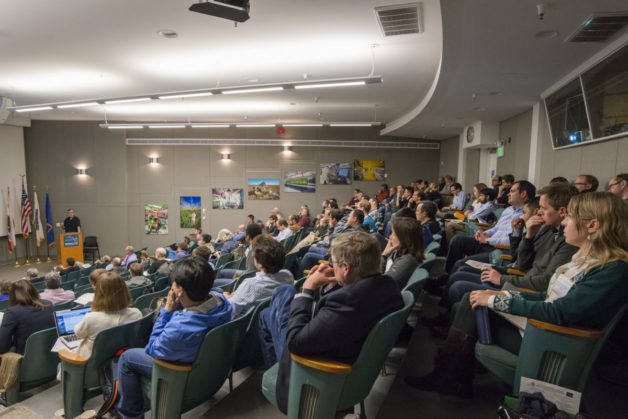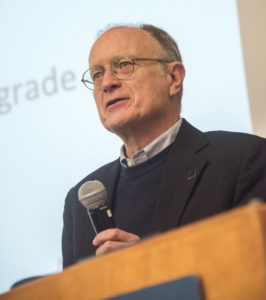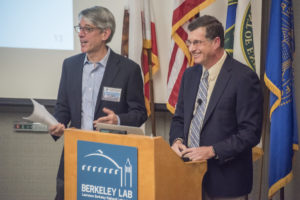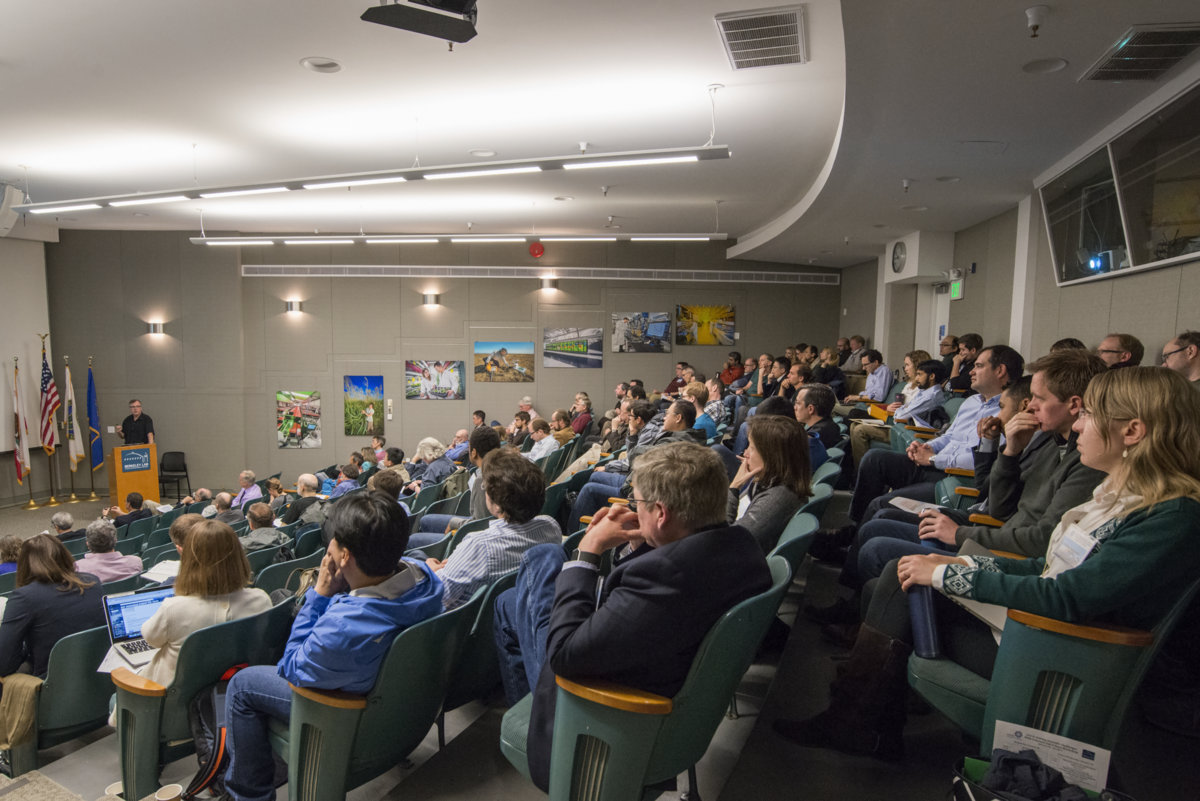
Howard Padmore, at podium, who leads the Experimental Systems Group at Berkeley Lab’s ALS, discusses science possibilities for a planned ALS upgrade project. (Credit: Marilyn Chung/Berkeley Lab)
Visiting scientists met Jan. 18-20 at Berkeley Lab for a workshop that collected input on the range of new science that will be enabled by the planned upgrade of the Lab’s Advanced Light Source.
The upgrade project, known as ALS-U, will boost the brightness, focus, and other properties of the light beams produced at the ALS.
The ALS is a type of synchrotron: It creates and accelerates powerful electron beams that emit light as they travel around bends. This light, which ranges from infrared to X-ray wavelengths, is channeled to dozens of beamlines, where it is used to explore a variety of sample types at microscopic scales for experiments that span from materials science and chemistry to environmental science and biology.
The ALS is optimized for the generation of so-called “soft” X-ray light, which has the appropriate energy to interact strongly with the electrons that determine the chemical, electronic, and magnetic properties of materials. Thousands of researchers from around the world travel to Berkeley Lab each year to take advantage of this experimental resource.
ALS-U would replace the circular array of magnets at ALS with a new array of more powerful, compact magnets capable of producing soft X-ray beams with up to 1,000 times higher brightness. It would also add a secondary ring of equipment that will replenish the electrons in the main ring. ALS-U’s light beams will be nearly continuous and will be more laser-like or “coherent,” which is a key enabling technology for new science.
On Sept. 27 ALS-U cleared the first step in a formal DOE project approval process, and ALS-U project staff are now drawing up detailed plans to prepare for the next stage of review and approval in this process.
The workshop featured talks by Berkeley Lab’s director, ALS-U project team members, and scientists who conduct experiments at the ALS, as well as a series of breakout sessions that collected recommendations on specific experiments that would benefit greatly from the upgraded ALS. These recommendations will form the basis for a report that will be prepared in the coming weeks to highlight how ALS-U’s unique capabilities, like the imaging of chemical and material structure at the nanoscale, can be used to address formerly unreachable scientific challenges.
The breakout sessions covered topics ranging from quantum and spin materials to bioscience, chemistry and catalysis, and energy materials.

Berkeley Lab Director Mike Witherell delivers a welcome address during an ALS-U workshop. (Credit: Marilyn Chung/Berkeley Lab)
Berkeley Lab Director Mike Witherell said that of the many workshops planned at the Lab this year, “no one of them is as important to the laboratory as this one is.” He added, “I look forward to getting the report of this workshop and using it to help make the case for the Advanced Light Source Upgrade.”
David Robin, ALS-U project director, told attendees, “Your participation is critical in shaping the direction and the ultimate success of ALS-U. We want to have both a very compelling scientific case and one where it’s clear that ALS-U is the best place to carry out that science.”
Steve Kevan, the science lead for ALS-U and ALS deputy for science, said that although the project will take a number of years to complete, “We’ll be making decisions in the next year or two that determine the impact of the whole thing. We need to know about instruments, we need to know about sample environments, we need to know about ancillary tools” that scientists need to fully utilize ALS-U, he said.
Howard Padmore, the group leader for ALS experimental systems, said new nanofocus beamlines in the works at the ALS provide a sort of sneak peek at the new beamlines that ALS-U will be designed to serve. “They have a lot of the techniques, the optics, the necessary infrastructure for a coherent beamline, so in a sense they’re a model for what we might build on ALS-U.”
In addition to the brightness of the beams enabled by ALS-U, its new capabilities bring a “smorgasbord” of new possibilities, Padmore said. ALS-U would enable a single beamline to deliver a combination of different types of light to experiments, for example, including “VUV” or so-called vacuum ultraviolet light, and “tender” X-rays, which have a higher energy than soft X-rays.
Peter Johnson, a member of the Condensed Matter Physics & Materials Science Department at Brookhaven National Laboratory, gave a talk describing how ALS-U could potentially shed new light on the still-mysterious properties of high-temperature superconductor materials.
And Pupa Gilbert, a physics and chemistry professor at the University of Wisconsin-Madison, provided examples of how ALS-U could provide far greater resolution and speed for experiments including nanoscale studies of shale rocks important for methane exploration, and biomineral formation on corals that can provide new insight on reef growth and degradation.

Advanced Light Source Director Roger Falcone, left, and ALS-U Project Director David Robin address attendees during an ALS-U science workshop on Jan. 18. (Credit: Marilyn Chung/Berkeley Lab)
Robin said, “We think (this upgrade) will allow ALS-U to generate soft X-ray beams with brightness near the fundamental limit of what is possible with any currently envisioned storage-ring technology and will present many exciting scientific possibilities.”
The Advanced Light Source is a DOE Office of Science User Facility and is supported by the DOE Office of Basic Energy Sciences.
For more information about the ALS-U project, visit: http://als.lbl.gov/als-u/overview.
